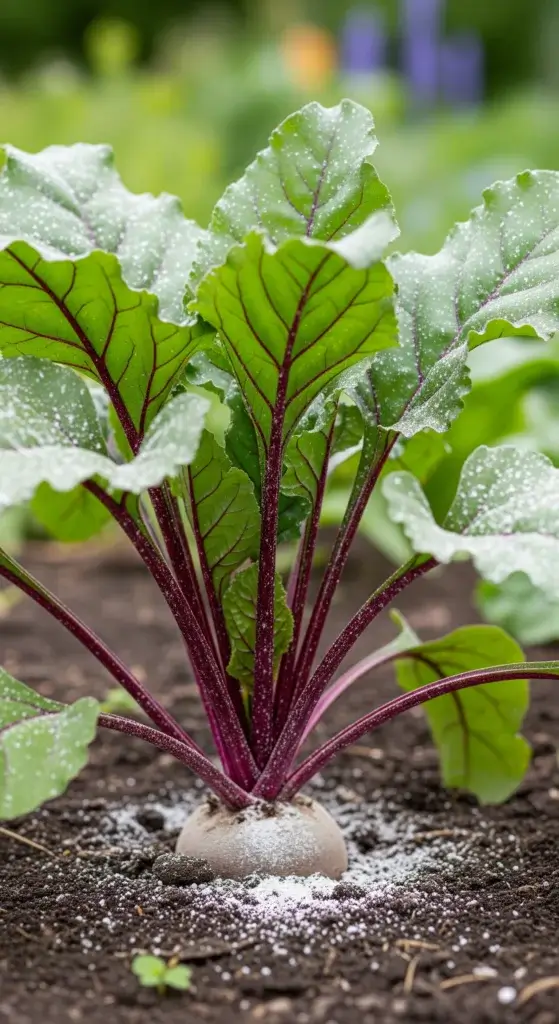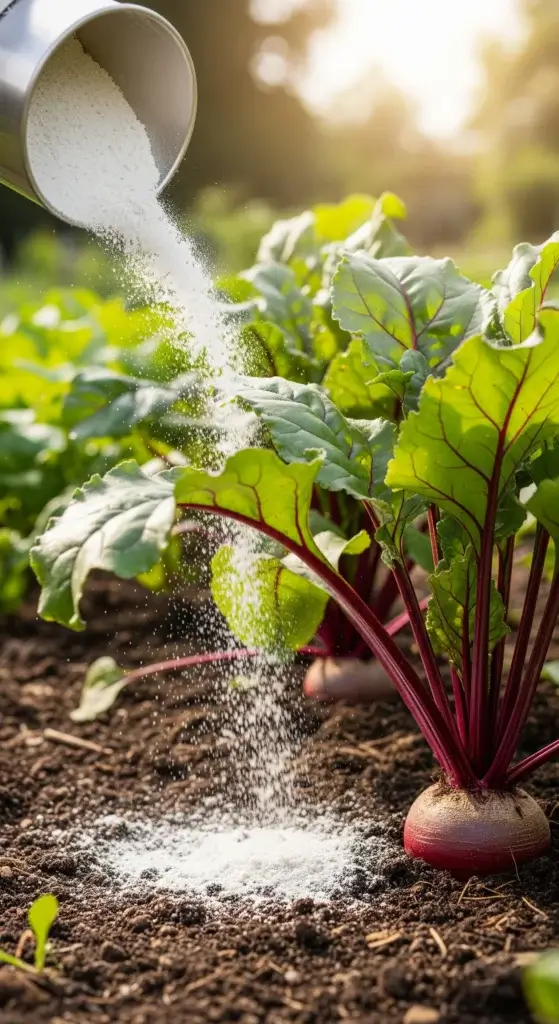
Flea beetles love beets—and not in a good way.
They chew tiny holes in the leaves and mess with plant growth fast.
Skip the harsh chemicals. Grab diatomaceous earth instead.
It’s natural, easy to use, and knocks beetles out without hurting helpful bugs or your family.
Understanding Beetroot Beetles: The Enemy in Your Garden
Flea beetles are small, jumping bugs from the Chrysomelidae family, and they love beetroot leaves—especially the young, tender ones.
They move fast, eat nonstop, and multiply like crazy. If you don’t catch them early, they can wreck your crop.
How to spot the damage
Here’s what to look for:
- Tiny round holes in the leaves (like someone peppered them with a mini shotgun)
- Leaves that look like lace—just the veins left behind
- Plants growing slow because they can’t make enough food
- Yellow leaves that fall off too soon
- Little dark beetles hopping around on warm days
Seedlings and baby plants take the hardest hit.
Older plants might survive, but even they have a rough time if the beetles go wild.

What Is Diatomaceous Earth?
Diatomaceous earth, or DE, comes from crushed-up fossils of tiny water creatures called diatoms.
Their skeletons are made of silica—basically a mix of sand and oxygen.
We mine this fossil dust, grind it into powder, and use it for everything from filtering pool water to fighting garden pests.
How DE wrecks beetles
Beetles don’t need to eat DE—it works just by touch.
When they crawl through it, the tiny sharp edges slice up their waxy outer layer (kind of like crawling through broken glass).
Once that layer’s busted, the bug starts drying out—and it’s game over.
How it works, step-by-step:
- Contact – Beetles walk through the DE.
- Abrasion – Sharp particles cut into their armor.
- Dehydration – They lose water and die in about 1–2 days.
Types of Diatomaceous Earth for Garden Use
Not all DE is garden-safe. You’ve got two main types—only one belongs anywhere near your beets.
Food-grade DE
This is the one you want. It has less than 2% crystalline silica, which makes it safe to use around people, pets, and good bugs (as long as you don’t go wild with it).
Always check the label—if it doesn’t say food-grade, don’t use it in your garden.
Pool-grade DE
Hard no. This stuff is made for filtering pool water, not killing bugs.
It has way more crystalline silica and can seriously mess up your lungs if you breathe it in.
Keep it far away from your plants, your face, and anything living.
Application Methods for Beetroot Beetle Control
DE works, but only if you use it right. Here’s how to hit beetroot beetles where it hurts—whether you’re going dry or wet.
Dry method
When to use it?
Early morning when the leaves are damp from dew, or right after a light watering.
That little bit of moisture helps DE stick.
Steps:
- Grab a flour sifter or a duster.
- Sprinkle a light coat of food-grade DE on the leaves—top and bottom.
- Dust the soil around the base too. Beetles love to hide there.
- Reapply after it rains or if you water hard.
Wet method
When to use it?
When it’s dry out or you want to target a beetle hotspot.
Mix this up:
- 1–2 tablespoons of food-grade DE
- 1 gallon of water
- A few drops of mild soap (helps it stick)
Now spray:
- Cover all beetroot leaves, especially the undersides.
- Focus on places where beetles are partying.
- Let it dry fully before checking results.

Strategic Application Timing
Timing matters. If you want DE to actually work against flea beetles, you’ve gotta catch them at the right moment.
When beetles are most active
Flea beetles show up early and stay busy. Here’s when to strike:
- Early spring – Adults wake up hungry. Hit them fast.
- Late spring to early summer – They’re laying eggs. Don’t give them the chance.
- After rain – Rain washes DE off, so reapply right away. Beetles love this window.
- Cool mornings – Beetles move slower. Easier targets.
Preventive vs reactive sprinkling
Preventive
Dust your plants before beetles show up.
This works best if you’re also rotating crops or planting bug-repelling buddies like radishes.
Reactive
See holes? See bugs? Dust now.
This method still works, but you’ll probably need more DE and more time to knock things back under control.
Safety Considerations and Best Practices
DE is natural, but that doesn’t mean you should treat it like powdered sugar.
If you use it wrong, it can mess with your lungs, skin, and even your garden’s good bugs. Play it smart.
Protect yourself
Breathing in too much DE can irritate your nose or throat.
On your skin, it can dry you out or make you itchy.
- Wear this when applying:
- A dust mask or N95
- Long sleeves and pants
- Gloves
- Safety glasses if you’re sprinkling above your head
Think of it like suiting up for a garden boss battle.
Protect the good bugs
DE doesn’t pick sides—it takes out all bugs with hard shells. That means bees and ladybugs are at risk too.
Do this instead:
- Only dust spots where you actually see pests
- Don’t apply during pollinator party hours (mid-morning to afternoon)
- Avoid dumping DE all over your garden—use it like a sniper, not a grenade
- Gently brush DE off flowers if you accidentally hit them
Maximizing Effectiveness: Integration with Other Control Methods
Diatomaceous earth is strong, but it’s not a solo act.
Team it up with other simple tricks and you’ll keep flea beetles in check without turning your garden into a war zone.
Physical barriers
Row covers work great. They stop beetles from landing on your plants in the first place.
- Use them in early spring, when beetles are most active
- Take them off once your beets are bigger and tougher
Cultural controls
These low-effort moves make a big difference:
- Crop rotation: Don’t plant beets in the same spot every year
- Delay planting: Wait until most beetles have come and gone
- Companion plants: Add catnip, basil, or marigolds—beetles hate them
- Healthy soil: The better your soil, the stronger your plants = less beetle damage
Watch closely (monitoring + timing)
You can’t fix what you don’t see. Check early, hit early.
- Check your beets once a week during beetle season
- Use yellow sticky traps to catch adults and keep count
- Flip leaves—beetles love hiding underneath
- Take notes so you know when they show up next season

Environmental Impact and Weather Considerations
Diatomaceous Earth (DE) can help mess up beetles and cutworms, but only if you play the weather game right.
Here’s how to use it without wasting your time (or your DE).
Rain
Heavy rain washes DE off your plants—bye-bye protection.
You’ll need to reapply after storms. Light mist or dew? That’s actually helpful.
It makes DE stick better and boosts bug contact. Win-win.
Wind
Don’t apply DE on windy days unless you want it flying into the neighbor’s yard (or your face). Calm days help you hit the right spots and avoid hurting good bugs like ladybugs or bees.
Hot days
Beetles get more active when it’s warm. Use DE on sunny days when they’re crawling around the most.
More bugs = more chances for DE to do its thing.
Troubleshooting Common DE Application Problems
Even pros hit bumps when using diatomaceous earth.
Here’s how to handle the usual problems so you don’t waste time or powder.
Problem: DE won’t stick
If it’s sliding off your plants like bad sunscreen:
- Apply early in the morning when there’s dew
- Mist the plants lightly before dusting
- Add a little liquid soap if you’re spraying it on wet
Problem: Patchy coverage
Some spots get too much, others get nothing. Here’s how to fix it:
- Apply in light, even layers—not one heavy blast
- Move in a consistent pattern (don’t just wing it)
- Practice on a few “test” plants first if you’re new to it
Problem: Beetles Keep Coming Back
You zap them, and they respawn like video game villains. Try this:
- Apply more often during peak beetle season
- Dust around nearby soil, not just the plants—beetles hide there
- Mix DE with other tricks like row covers or companion planting

Advanced Application Techniques
Once you’ve got the basics down, try these next-level tricks to really lock things down.
Build a bug border
Make a 6-inch wide ring of DE around your beet beds. Think of it like a dry moat—beetles hate crossing it.
This keeps them from sneaking in from untreated spots.
Mix it into the soil
Sprinkle DE into the top inch of soil around your plants.
This hits beetles while they’re still larvae underground. It also sticks around longer than surface dusting.
Stack your methods
Layer your defense:
- Start with soil mixing
- Follow up with a dry dusting on the leaves
- Spot-treat hot zones with a wet spray
It’s like setting up a DE obstacle course. The beetles won’t stand a chance.
Final Take: DE Is Your Garden’s Secret Weapon
Diatomaceous earth gives you solid, natural control over beetroot beetles—no chemicals, no drama.
It’s safe for people, pets, and the bugs you do want around.
To make it work, you need to apply it right and mix it with other smart strategies like crop rotation and row covers.
DE won’t zap pests instantly, but it delivers steady, long-term control if you stick with it.
Start small, see what works, and adjust as you go.
With patience and good timing, DE can be your go-to tool for a healthy, beetle-free beetroot patch.



